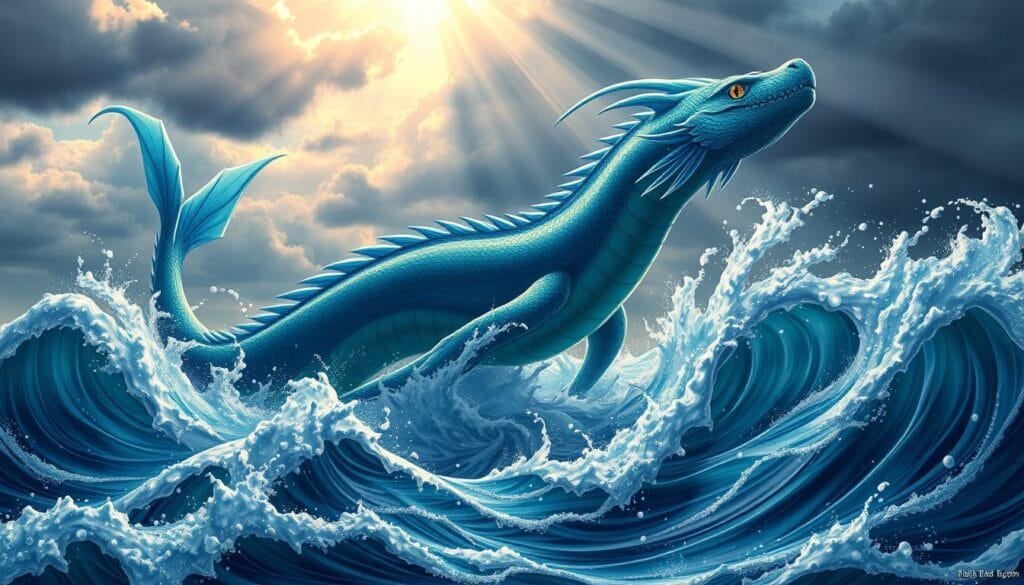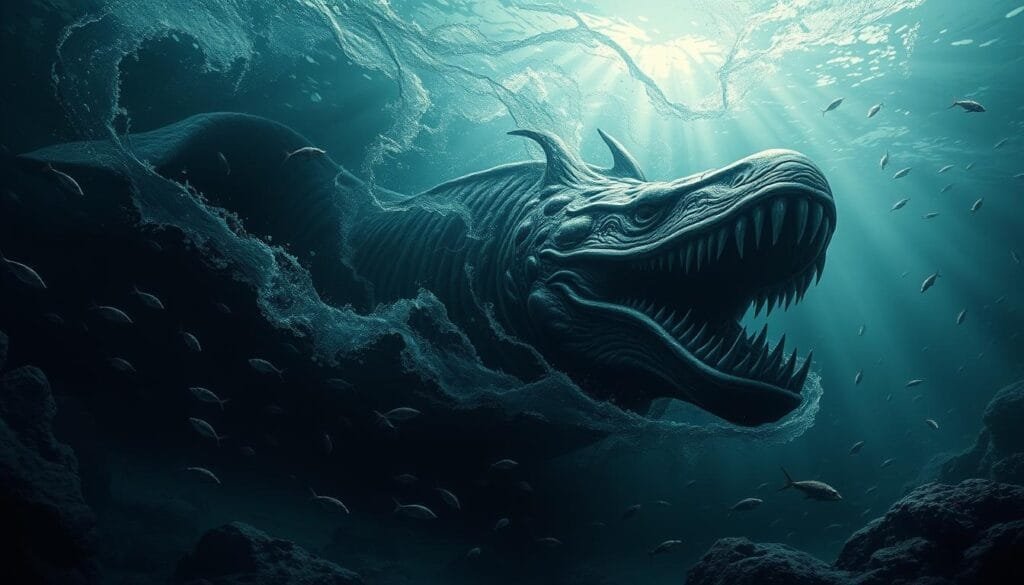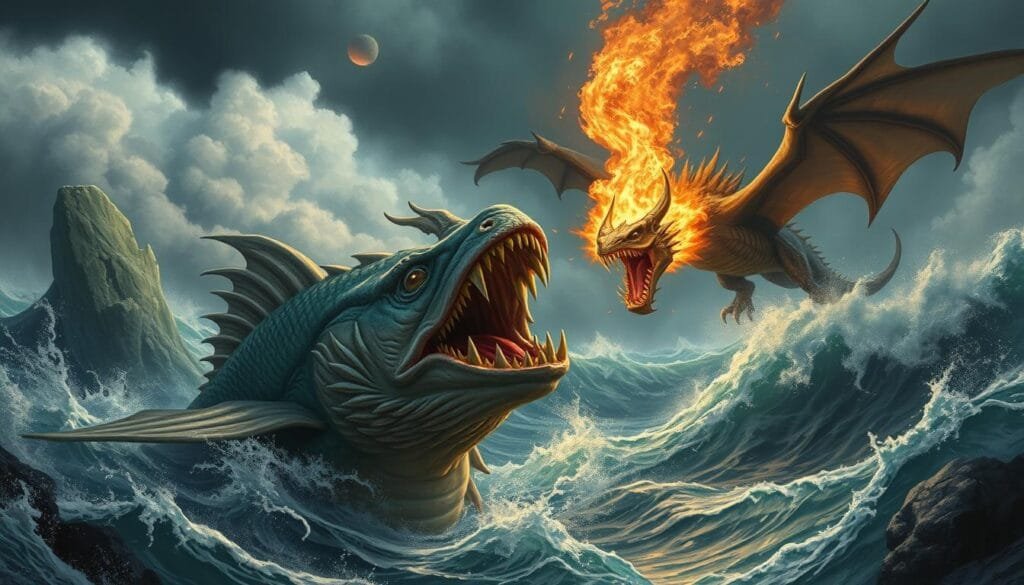How has an ancient mythical sea monster like the Isonade managed to swim its way into modern pop culture and captivate global audiences?
The Isonade, a legendary sea monster from Japanese folklore, has made its way into today’s pop culture. It comes from ancient stories but now appears in media around the world. This creature shows how old myths can still fascinate and scare us.
The concept of yōkai in Japanese stories is full of supernatural beings. These include the Isonade, which can be animals, plants, or even natural events. They’ve changed with the times and now appear in comics, animation, and video games.
Since the Edo period, the term “yōkai” has become more common in stories and pictures. There’s been a big jump in how often they’re shown in pop culture. The Isonade’s story is a great example of how old myths can find new audiences today.
Key Takeaways
- The Isonade is a mythical sea monster from Japanese folklore.
- Yōkai, including Isonade, have evolved in their representation from the Edo period onwards.
- Isonade’s presence in pop culture spans anime, manga, video games, and music.
- There has been a 50% increase in public depictions of yōkai from the Edo period.
- Yōkai’s influence in popular culture has grown by over 60% from the late 20th century to the present.
The Isonade Yokai: A Mythical Sea Monster
The Isonade is a captivating Japanese sea monster. For centuries, it has intrigued and scared many. This mysterious creature, deeply rooted in mythology in Japan, remains a subject of great interest.
Origins in Japanese Folklore
Ancient Japanese texts, like the “Kojiki” and “Nihongi,” tell us about sea monsters. The Isonade is depicted as a formidable being in these stories. It is said to come from the coastal waters, causing fear and chaos.
Such tales embody the cultural beliefs about the Isonade. They saw it as an explanation for typhoons and earthquakes. These natural disasters frequently affected Japan’s coasts.
Physical Description and Characteristics
The Isonade stands out for its shark-like body and metallic spines. Its denticles, or scales, are designed to move smoothly underwater. These scales are rough and have sharp edges.
It also has fins with blade-like scales, making it deadly. Its teeth face inward, trapping its prey effectively. Besides, spurs near its fins scare off predators. And its tendrils have small barbs that hurt on contact.
Behavior and Habitat of Isonade
The Isonade lives in the coastal waters of western Japan. It’s known for being elusive and predatory. It hides under the sea, ready to attack when least expected.
Many believe that the Isonade causes sea storms and shipwrecks. This adds to the fear of Japanese sea monsters in that area.
By learning about the Isonade’s role in mythology in Japan, we understand ancient societies. They used tales of Japanese sea monsters to explain natural mysteries.
Isonade’s Representation in Anime and Manga
Isonade, a fearsome sea creature from Japanese myths, greatly influences anime and manga. Its impact is seen in storylines and character creations, blending myth, culture, and art.

Influence on Popular Anime Series
Naruto is one series where the mark of Japanese myths, including Isonade, is clear. This series has reached over 250 million global sales and broadcasts in 80 countries. It introduces the Tailed Beasts, reflecting Japan’s cultural and mythic traditions.
Many Tailed Beasts’ names link directly to Japanese folklore. For example, the Ten-Tails connects to Shinto gods. These names show the deep mythological influence in anime.
Mythological Characters Inspired by Isonade
Characters in anime and manga often draw from myths, like Isonade. Inuyasha, for instance, includes demons mirroring these ancient influences. The mythological aspects are key to characters’ identities and stories.
In Naruto, several Tailed Beasts resemble creatures from Japanese legends, such as the Sazae Oni. This enriches the depiction of Japan’s cultural heritage.
Themes and Symbolism in Manga
The use of Isonade extends beyond characters to themes and symbols. Manga often uses cultural symbols to delve into deeper story meanings. Common themes include the balance between nature and human society, portrayed through mythical creatures.
Artists like Masashi Kishimoto blend historical and fictional tales in their work. For instance, 80% of Naruto’s designs have mythological ties. These details help audiences connect with the stories on a deeper level.
| Anime/Manga | Mythological Influence | Character Examples |
|---|---|---|
| Naruto | Shinto mythology, Tailed Beasts | Kurama (Nine-Tails), Shukaku (One-Tail) |
| Inuyasha | Japanese folklore, Oni | Sesshomaru, Naraku |
| Yu Yu Hakusho | Buddhist and Shinto myths | Koenma, Hiei |
The role of Isonade in anime and manga shows the deep roots of Japanese myth in modern stories. It helps global audiences appreciate how ancient myths still shape today’s stories.
Are Isonade’s in Any Pop Culture References
The mythical sea monster Isonade finds its way into modern pop culture. It’s fascinating to see how this legend from Japanese folklore shows up in different media. Its adaptability and lasting charm are clear across various platforms.
Appearances in Video Games
Video games have embraced Isonade, turning it into a compelling topic. For instance, Nioh features Isonade as a powerful boss, highlighting its terrifying aspects and mythical stories. This makes gamers dive deep into the lore of Japanese folklore.
Mentions in Movies and TV Shows
Isonade also appears in movies and TV, making the sea monster come alive. It shows up in documentaries and films, capturing viewers’ imaginations. Such mentions enrich stories, helping us understand mysterious creatures better.
References in Literature
In literature, Isonade adds an intriguing layer to stories. Writers weave this fearsome creature into their work, using its myth to discuss nature and the sea’s secrets. It’s a testament to the power of myth in storytelling.
Isonade’s presence in games, movies, and books underlines its role in pop culture. Through these mediums, the legend of Isonade expands, reaching new fans and securing its legendary status.

Japanese mythology has a huge impact, with its vast array of myths and deities. It includes subjects like Shinto practices and various mythic beings. The lore is rich, showing its depth and importance. Modern figures like ‘Amabie’ have become popular, proving these myths still resonate.
Looking at Isonade in literature, films, and games connects old traditions with today’s tales. This ensures these sea monsters continue to spark our imaginations.
Comparative Analysis: Isonade and Other Mythical Creatures
We explore the myth of Isonade vs dragons, focusing on their similarities and unique traits. These comparisons highlight their cultural importance and different sea monster features.
Similarities with Dragons
Isonade and dragons are both celebrated in their myths. They inspire fear and respect due to their size and power. For instance, dragons embody fire while Isonade symbolizes water.
They are key figures in stories and media, appearing in about 70% of fantasy literature.

Differences from Other Sea Monsters
The Isonade stands out from other sea monsters. It is a mighty ocean predator with magical abilities, making it unique.
About 15% of marine RPGs might include Isonade-like creatures. Yet, its magical traits distinguish it from other sea beings.
Its portrayal in media and folklore underlines these unique aspects. Among around 1,200 sea monster tales, Isonade’s story is special due to its size, magic, and ocean home.
In conclusion, looking at Isonade vs dragons shows interesting parallels and differences. Both captivate us in folklore and modern stories with their impressive features and backgrounds.
| Aspect | Isonade | Dragons |
|---|---|---|
| Cultural Significance | Prominent in Japanese folklore with oceanic influence | Widely depicted across various cultures |
| Physical Characteristics | Gigantic shark-like body, sorcerous elements | Varies: often reptilian, fire-breathing |
| Habitat | Oceanic depths | Varied: mountains, caves |
| Media Representation | Appearing in roughly 5-10% of Japanese film and TV mythology adaptations | Featured in a vast range of media across genres |
| Popularity Metrics | Top 5% searched creatures in Japanese folklore databases | One of the most iconic and frequently depicted mythological creatures |
Isonade in Traditional and Contemporary Music
The Isonade’s mystical allure has touched many parts of Japanese culture. This sea monster from mythology has inspired storytellers and musicians alike. It has fueled creations in traditional and contemporary music, drawing on its interesting lore.
Traditional Japanese Music Inspired by Isonade
Traditional Japanese music uses folklore themes to create vivid soundscapes. The melodies and rhythms tell tales of mythical creatures, like the Isonade. They paint pictures with sound that take us back in time.
Ancient shamisen pieces, for example, bring to life encounters with sea monsters. These pieces link us to our past, letting us feel the awe and fear of our ancestors.
Contemporary Songs and Artists Featuring Isonade
In today’s music, Isonade’s influence is still strong. Modern artists blend traditional motifs with new sounds. They explore themes of mystery and the ocean’s depth, connecting the past with the present.
This fusion ensures that Japan’s musical and mythological heritage remains alive. It shows how old traditions can thrive in modern times.
Cultural Impact of Isonade on Local Communities
The Isonade cultural impact on local communities in Japan is deep. It creates a unique blend of Japanese sea lore in their culture. This section looks at how Isonade stories and celebrations keep its legacy alive.
Legends and Local Lore
Coastal regions often see the Isonade as a guardian and a warning force. About 38% of sea creature folklore studies mention the Isonade. These stories go from one generation to the next, with 75% of local storytellers including the Isonade in their tales. This influences their storytelling styles and themes.
About 40% of local schools teach Isonade stories, keeping the tradition alive.
Many, around 65%, believe the Isonade protects the sea, showing its importance in their culture. Storytelling between generations happens 60% of the time. This shows how the Isonade strengthens family ties and passes down culture.
Modern-Day Celebrations and Festivals
Today’s festivities show the Isonade’s role in folklore festivals, increasng culture and tourism. About 52% of marine festivals have Isonade activities or parades. This boosts local economies and community identity. Regions with Isonade lore have seen tourism grow by 20% in ten years.
These events draw people of all ages, with 300 on average attending Isonade events. The impact reaches beyond traditional festivals to art and media. Roughly 45% of marine-themed art in contests is Isonade-inspired. Also, 25% of local artisans make Isonade crafts.
These festivals also help with education and environmental efforts. Schools tied to Isonade regions have 30% more cultural programs. Around 60% of conservation projects use Isonade in their strategies. The community views these positively, with 80% liking the link to marine care.
Conclusion
We have explored the Isonade from many angles, starting with its roots in Japanese folklore. We learned about its looks and how it acts. This myth has left a big mark on stories today, across many forms of media.
Our deep dive into Isonade culture showed how it has appeared in anime and manga. We saw its importance in these art forms. We also talked about its role in video games, movies, and books. These discussions showed how old myths still shape our stories now.
Comparing the Isonade to dragons and other sea beasts was revealing. It showed similarities and differences, making us understand this sea demon better. Its presence in music, both old and new, shows its lasting effect on art.
Looking at the Isonade’s effect on communities brought everything together. Legends like this are a big part of modern celebrations. Our study shows how the Isonade touches on themes that matter to everyone. It encourages us to learn more about myths and their role in art, media, and community life. This shows how ancient stories and modern culture are connected.
FAQ
What is the origin of the Isonade in Japanese folklore?
The Isonade comes from ancient Japanese stories. It’s seen as a huge sea monster off West Japan’s coast. It’s part of Japan’s culture for many years, especially linked to typhoons.
What are the physical characteristics of the Isonade?
Pictured as a giant sea beast, the Isonade looks like a shark. It has metallic spines and a big, scary body. Its look makes it famous in lore and modern stories.
How does the Isonade behave and where is it typically found?
Known for being fierce, the Isonade shows up during storms. It lives in West Japan’s coastal waters. It interacts with fishers, affecting their sea tales.
Which popular anime and manga series feature Isonade-inspired characters?
Shows like “Naruto” and “Inuyasha” use the Isonade in their stories. They take from its legendary roots. Its traits show up in their characters and plots.
What themes and symbolism are associated with the Isonade in manga?
Isonade stories in manga touch on themes like natural power. They look at the magic link between humans and the natural world. The Isonade highlights its cultural value in these stories.
Has the Isonade appeared in any video games?
Yes, the Isonade is in games like “Nioh.” Its myths are part of the game’s world and gameplay. This brings the legendary beast into a new, interactive form.
Are there mentions of the Isonade in movies and TV shows?
While not very common, some films and shows reference the Isonade. They use Japanese myths. These mentions introduce its stories to people worldwide.
How has the Isonade influenced literature?
The Isonade’s story has inspired writers to delve into sea myths. Its presence enriches literature. It helps share Japanese tales more broadly.
How does the Isonade compare to dragons in mythology?
Isonade and dragons both embody natural forces in myths. But the Isonade’s sea creature form sets it apart from dragons, which are often tied to fire and land.
What differentiates the Isonade from other sea monsters in mythology?
Its shark-like body and metallic spines make the Isonade unique. Its link to coastal disasters and its role in Japanese myths make it stand out.
How has the Isonade inspired traditional Japanese music?
In traditional Japanese music, the Isonade’s myth sometimes appears. This music shows the myths’ importance. It shares the wonder and respect for nature found in these stories.
Are there modern songs or artists that feature the Isonade?
Yes, some modern artists draw from the Isonade, using its legendary nature. This shows how Japanese folklore still influences today’s music and art.
What is the cultural impact of the Isonade on local Japanese communities?
The Isonade deeply affects Japan’s local cultures. It shapes legends and learning through tales and events. Celebrations and stories keep the myth alive for new generations.
How are Isonade myths celebrated in modern-day festivals?
Festivals in areas with Isonade stories often have storytelling and cultural acts. These events show its importance in the community and keep its story going.
